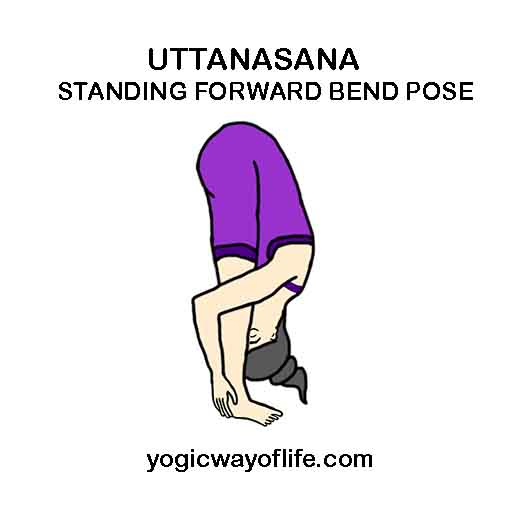Uttanasana or the Standing Forward Bend Pose involves intense bending of the hips and creates a very flexible body. In Sanskrit, Ut means Intense, Tana means stretched and Asana means a yogic pose.
How to do Uttanasana (Standing Forward Bend Pose)?
- Start in the standing position or Tadasana. Place the hands on the hips.
- Take a full breath and expand your chest. Slowly exhale and fold over the hips and bend forward. Keep the torso and head in one line. At this stage the upper body will be perpendicular to the legs.
- Now bend further and try to place the hands on the floor on the side of the legs. This requires some level of flexibility. This will loosen your hamstring muscles over a period of time. If you are not able to touch the floor with the hands, do not strain. Just go as far as you can without pain. With practice, the hamstring muscles will loosen up and you will be able to touch the floor with the hand. Make sure you do not bend the knees while performing this asana.
- Advanced practitioners can bring the head to rest between the thighs and the hands can clasp the ankles.
- Maintain this position for as long as you are comfortable.
- To release the position, inhale and bring back the hands to the hips and raise yourself up to the standing position.
- If you feel any pain in the hips or groin region, do not go further than it hurts. Also it is good to follow this up with backward bending poses like Makarasana, Bhujangasana, Dhanurasana or Ushtrasana as a counter pose.
Benefits of Uttanasana (Standing Forward Bend Pose)
- Uttanasana is one of the best poses to loosen up the hamstring muscles.
- It gives flexibility to the hips.
- Uttanasana removes fat around the belly and hips.
- It stretches the muscles of the back and the spine.
- Uttanasana tones the organs in the abdomen and improves digestion.
- It relieves stress in the shoulder, back and neck muscles.
- It improves blood circulation and metabolism.
- Uttanasana can give some benefits of the inverted asanas as there is more blood flow to the brain.
Avoid Uttanasana asana if you suffer from any injury of the hips, knees, shoulders or legs. Also, those with stiff hips and lower back should perform this pose with care without strain.

